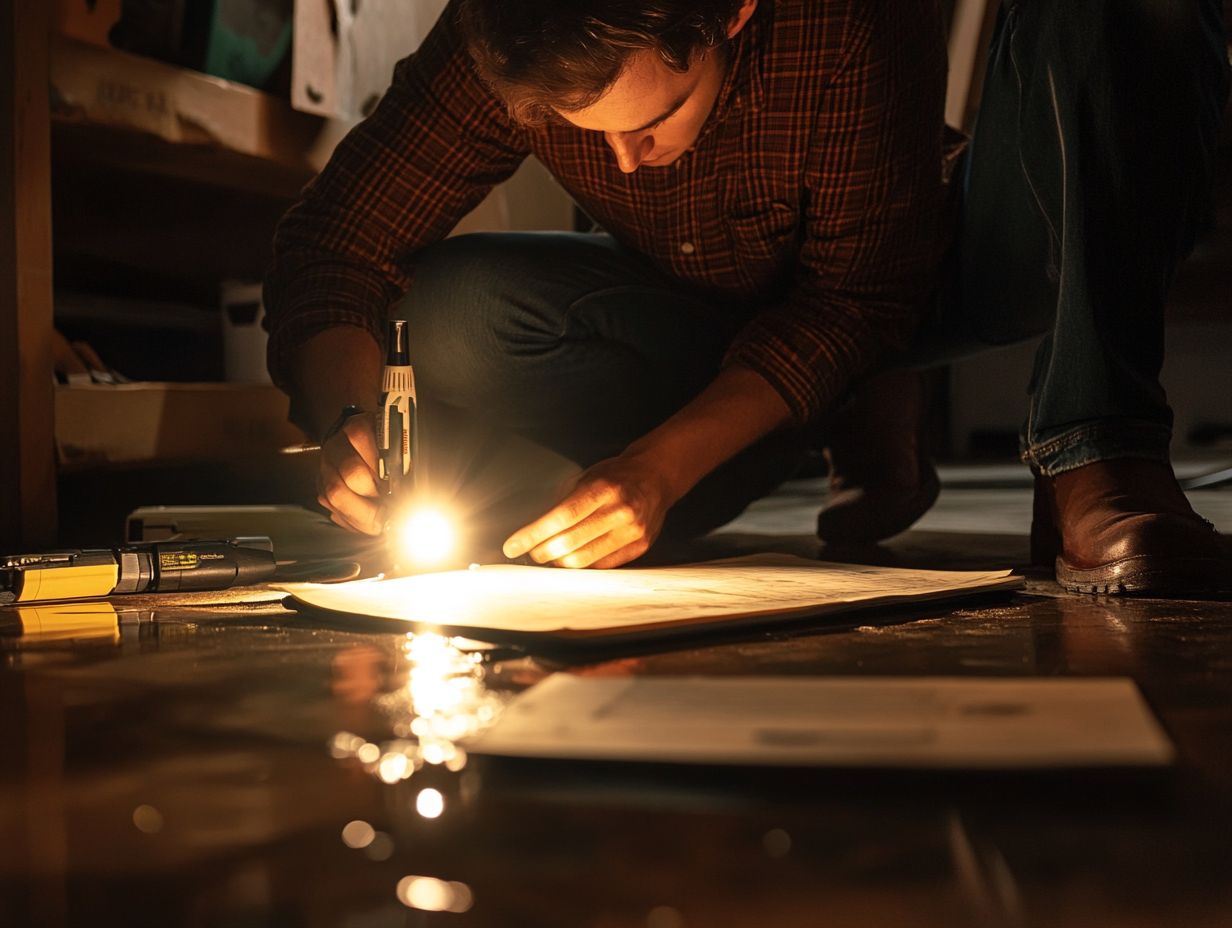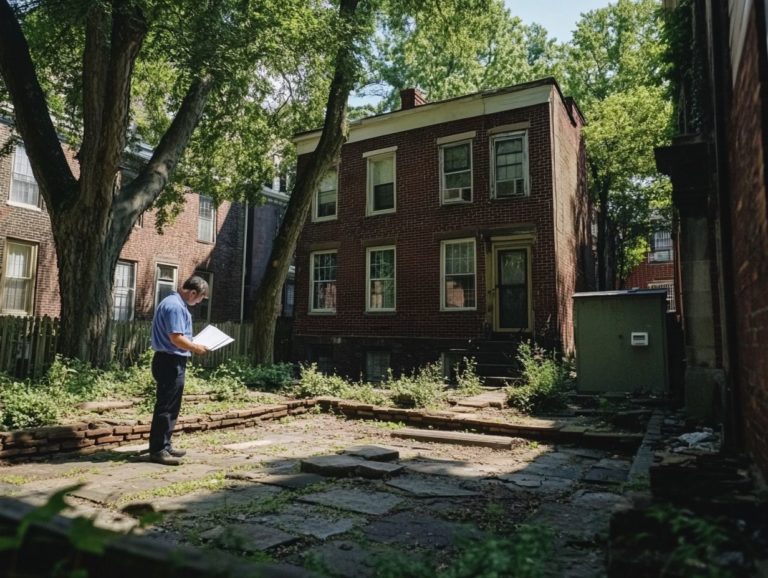5 Warning Signs During a Home Inspection
When you’re in the market to buy or sell a home, recognizing potential red flags is essential. A home inspection can uncover hidden issues that might significantly impact your investment.
This article outlines five common warning signs like water damage and structural problems that could surface during an inspection. It also emphasizes the importance of home inspections, the different types available, and how they can affect your buying or selling journey.
You will also discover how to prepare for an inspection and tackle any issues that arise. Dive in to ensure you’re fully equipped with the knowledge needed before making your next major decision!
Contents
- Key Takeaways:
- 1. Water Damage
- 2. Structural Issues
- 3. Electrical Problems
- 4. Plumbing Concerns
- 5. Pest Infestations
- What Is a Home Inspection and Why Is It Important?
- Frequently Asked Questions
- What are the 5 warning signs to look out for during a home inspection?
- What are some common structural issues found during a home inspection?
- What are the dangers of water damage in a home?
- Why is it crucial to have an electrician inspect the electrical system during a home inspection?
- What are some signs of plumbing issues found during a home inspection?
- Why are pest infestations a concern during a home inspection?
Key Takeaways:

- Water damage can indicate issues with the foundation or roof. Inspect for leaks or stains.
- Structural issues, such as cracks in the walls or foundation, can indicate costly problems.
- Electrical problems, like outdated wiring or faulty outlets, can pose safety hazards.
1. Water Damage
Water damage is a major concern for homeowners. It often arises from plumbing issues, faulty roofs, or inadequate drainage. If left unaddressed, it can lead to expensive repairs, mold growth, and safety hazards.
This type of damage can jeopardize the structural integrity of your home, impacting everything from the foundation to the framing. You need to know the different types of water damage: clean water, gray water, and black water. Gray water is slightly dirty, while black water is contaminated and needs special handling.
Regular inspections are crucial! Catch early signs to avoid bigger problems down the road. You should develop a comprehensive inspection checklist that includes what to look for in a home inspection report.
- Checking for leaks
- Ensuring proper ventilation
- Maintaining gutters
Simple maintenance measures, like sealing cracks and ensuring proper drainage, can significantly help prevent water-related issues in your home. Schedule your home inspection today to stay ahead!
2. Structural Issues
Structural issues in residential properties, such as foundation movement and drywall cracking, can seriously threaten the integrity of your home. These complexities often require the help of a structural engineer for a comprehensive evaluation.
These problems can arise from various sources, including inadequate drainage, significant soil movement, or even the encroachment of tree roots. As these issues develop, you might start to notice troubling signs like uneven flooring, doors that refuse to budge, or visible gaps around your windows.
Structural engineers are crucial in these situations. They not only identify the root causes of your concerns but also provide recommendations for necessary renovations.
Obtaining detailed inspection reports is essential for effectively addressing these issues. These documents become vital tools that empower you to make informed decisions about repairs, ensuring the long-term resilience of your home. Don’t wait to seek professional help!
3. Electrical Problems
Electrical issues, such as outdated aluminum wiring and knob-and-tube systems, present serious safety risks and regulatory hurdles. Therefore, it’s imperative for you to prioritize inspections that comply with current safety regulations and standards.
Understanding the importance of modern electrical systems is key to maintaining a safe, functional, and efficient living environment. Old wiring can lead to electrical fires, diminish efficiency, and create hazardous situations if not addressed.
To reduce these risks, you should regularly inspect outlets for signs of wear, avoid overloading circuits, and consult a professional electrician whenever concerns arise.
In the real estate market, thorough inspections not only protect buyers from hidden dangers but also boost property value. Updated systems tend to attract prospective homeowners who are looking for longevity and safety in their investments. Ensure your electrical system is safe and up-to-date!
4. Plumbing Concerns

Plumbing issues, whether they involve galvanized pipes or sewer dilemmas, can lead to serious water damage and structural complications. This underscores the importance of regular maintenance and comprehensive inspection checklists to catch potential hazards before they escalate.
Neglecting these common problems threatens your home’s structural integrity and can dramatically inflate repair costs. For example, leaks in aging pipes often lead to mold growth, compromising health and safety. By routinely inspecting fixtures, drains, and water heaters, you can spot early warning signs like discoloration or dampness. Knowing what to expect during a home inspection can also help you address these issues proactively.
Schedule professional plumbing inspections every few years. This helps uncover hidden issues before they turn into major headaches. Simple preventive measures, like clearing debris from drains and replacing worn-out seals, can significantly reduce the risk of costly emergencies while protecting your property s value.
5. Pest Infestations
Pest infestations, especially pesky termites, can dramatically undermine the structural integrity of your home. You must weave pest inspections into your routine for your home s safety it s a crucial step for effective home evaluation.
Think of these inspections as your proactive shield, catching potential threats before they balloon into pricey repairs. Regular assessments spotlight the usual culprits like rodents or ants and provide in-depth reports that help you grasp the severity of any infestations.
By staying attuned to pest activity, you can adopt preventive maintenance strategies, such as sealing entry points and keeping your space tidy, effectively safeguarding your sanctuary.
Ultimately, this diligence protects your property value and fosters a safer, healthier living environment for you and your loved ones.
What Is a Home Inspection and Why Is It Important?
A home inspection is more than just a routine check; it s a meticulous evaluation of a residential property that examines crucial elements like the foundation, roof condition, plumbing, and electrical systems. This assessment is essential for enhancing your awareness as a buyer and boosting your confidence in your investment, regardless of market conditions.
This detailed process is important for you as a buyer, providing invaluable insights that empower you to make informed decisions. Utilizing an inspection checklist ensures that every corner of the property is scrutinized, enabling comprehensive assessments that bring potential issues to the forefront.
The results of this inspection directly impact property appraisals, influencing the perceived value of the home and shaping your investment strategy. For buyers and investors, understanding these nuances instills a greater sense of security in your purchase, helping you navigate the risks associated with unexpected repairs or hidden defects.
What Are the Different Types of Home Inspections?
There are several types of home inspections available to you, including general inspections, specialized checks for pests or HVAC (Heating, Ventilation, and Air Conditioning) systems, and those focused on safety hazards each serving a distinct purpose in a thorough home evaluation.
These inspections are vital for uncovering hidden issues that might escape the notice of an untrained eye. A general inspection typically assesses the overall condition of your property, examining structural integrity, plumbing, and electrical systems. Meanwhile, a pest inspection focuses on potential infestations that could lead to significant damage.
HVAC inspections are also important for ensuring your heating and cooling systems operate efficiently, which enhances comfort and contributes to energy savings.
By tailoring these inspections to the unique characteristics of your home, you can improve the accuracy of the assessments and gain peace of mind about your investment.
How Can a Home Inspection Affect the Buying or Selling Process?

A home inspection is important for both buying and selling. It gives buyers insights and helps agents negotiate repairs or price changes.
The inspection results can affect your satisfaction with the investment. Sellers can address potential issues proactively to create effective strategies.
More buyers are looking for transparency. Clear communication about any problems can lead to better negotiations and fair deals.
What Are the Most Common Issues Found During a Home Inspection?
You’ll likely find issues like water damage, electrical problems, and structural concerns during an inspection. To avoid these common pitfalls, both buyers and sellers should refer to the top 10 things to check during a home inspection.
A detailed checklist is invaluable. It helps identify red flags that could lead to costly repairs and encourages transparent negotiations.
For example, mold can cause health issues, while old wiring can create safety hazards. Inspecting every part of the property can reveal necessary repairs that affect pricing.
Knowing these common issues helps discussions and can make transactions smoother.
How Can Homeowners Prepare for a Home Inspection?
You can get ready for a home inspection by fixing maintenance issues and familiarizing yourself with a checklist. Simple tasks like testing smoke detectors and cleaning gutters can enhance your home’s appeal.
Decluttering spaces allows inspectors to assess the property more easily. Checking the home’s exterior for wear, like peeling paint, can stop small problems from growing.
These proactive steps make the inspection go smoother. They help you present your property well and reduce potential red flags.
What Are the Options for Addressing Issues Found During a Home Inspection?
If problems come up during a home inspection, you have several options. You can handle repairs yourself or hire professionals for assessments.
Addressing issues quickly preserves your property’s value. Negotiating with buyers or sellers can lead to agreements on repair costs.
Gathering quotes from contractors helps you understand financial implications before making decisions. Consulting with real estate experts can also provide helpful strategies.
Frequently Asked Questions

What are the 5 warning signs to look out for during a home inspection?
The 5 warning signs include structural issues, water damage, electrical problems, plumbing issues, and red flags to look for in home inspections like pest infestations.
What are some common structural issues found during a home inspection?
Look out for foundation cracks, uneven floors, and roof damage. These could signal a serious issue that needs immediate attention! Be sure to review the most common findings in home inspections to stay informed.
What are the dangers of water damage in a home?
Water damage can lead to mold growth, which poses health risks. It can also weaken the home’s structure, causing rot over time.
Why is it crucial to have an electrician inspect the electrical system during a home inspection?
Electrical problems can be both dangerous and expensive. An electrician identifies fire hazards and unsafe wiring during the inspection.
What are some signs of plumbing issues found during a home inspection?
Look for leaks, low water pressure, clogged drains, and unusual odors. These can indicate plumbing problems that need addressing.
Why are pest infestations a concern during a home inspection?
Pest infestations can damage a home’s structure and pose health risks. An inspector can spot signs of pests and recommend solutions, addressing common home inspection issues.






